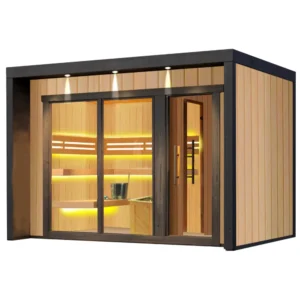When building a sauna, one of the most important decisions you’ll make is the type of wood to use. Hemlock, cedar, and other wood choices each bring unique benefits, but which is the best wood for your sauna? This article dives deep into
hemlock and compares it to other popular sauna woods like
cedar and
western red cedar. Whether you’re designing a
home sauna, an
infrared sauna, or a traditional steam sauna, this guide will help you make an informed decision. Let’s explore the qualities of
hemlock wood, its pros and cons, and how it stacks up against its competitors.
Why Wood Matters in Sauna Construction
The wood you choose for your sauna can significantly impact its
durability,
appearance, and overall
sauna experience. Saunas are exposed to high heat and humidity, so your wood type must be able to withstand these extremes without warping, cracking, or releasing harmful toxins. Beyond functionality, the wood also influences the
aesthetic and
aroma of your sauna.
1. What Makes Hemlock a Popular Sauna Wood?
Hemlock is a softwood commonly used in
sauna construction due to its affordability, light color, and strength. Its fine, even texture makes it a visually appealing choice for those seeking a clean and modern sauna aesthetic.
Benefits of Hemlock:
- Cost-Effective: Hemlock is often less expensive than premium woods like cedar.
- Non-Aromatic: Unlike cedar, hemlock doesn’t release a distinct scent, making it a good choice for those sensitive to strong aromas.
- Durability: While not as durable as cedar, hemlock can withstand the high humidity and temperatures of a sauna environment.
However, hemlock is not without its drawbacks. It’s more prone to warping and cracking over time, especially in extreme sauna conditions.
2. Hemlock vs Cedar: Which is Better for Your Sauna?
When comparing
hemlock to
cedar, several factors come into play, including
durability,
aesthetic, and
aroma.
FeatureHemlockCedar
DurabilityModerate (can warp)High (resistant to warping)
AestheticLight, modern lookRich, warm tones
ScentNeutralAromatic (natural oils)
CostAffordableModerate to high
Heat ResistanceGoodExcellent
Many sauna enthusiasts prefer cedar for its natural ability to resist cracking, its pleasant scent, and its luxurious appearance. However, hemlock remains a popular choice for budget-conscious buyers.
3. The Benefits of Cedar for Saunas
Cedar wood, particularly
western red cedar, is widely regarded as one of the
best woods for saunas. Its natural properties make it ideal for high-heat, high-humidity environments.
Why Cedar Stands Out:
- Aroma: Cedar emits a pleasant, woody scent that enhances the relaxing atmosphere of a sauna.
- Durability: Cedar’s natural oils protect it from moisture, mold, and decay, ensuring longevity.
- Heat Resistance: Cedar stays cool to the touch, even in high temperatures, making it more comfortable for sauna users.
Additionally, cedar is less likely to splinter or crack, making it a safer option for
infrared saunas or
traditional saunas.

4. Western Red Cedar: A Premium Sauna Wood?
Among the cedar varieties,
western red cedar is considered the gold standard for saunas. Its rich reddish-brown color and unique grain patterns make it a visually stunning choice. Western red cedar also boasts exceptional resistance to warping and decay, making it perfect for
home saunas or
outdoor sauna setups.
5. Hemlock in Infrared Saunas
Infrared saunas differ from traditional saunas, as they use infrared heaters to warm the body directly rather than heating the air. This difference places unique demands on the sauna’s wood.
Hemlock wood is a popular choice for infrared saunas due to its:
- Non-Aromatic Quality: Ideal for those who prefer a neutral-smelling environment.
- Affordability: Infrared saunas are often more affordable, and hemlock aligns with that cost-effective philosophy.
However, for users seeking added durability and luxury, cedar remains the top choice.
6. How to Choose the Right Wood for Your Sauna
When selecting the
right wood for your sauna, consider the following factors:
- Budget: Hemlock is more affordable, while cedar is pricier but offers more benefits.
- Aesthetic Preference: Do you prefer the light tones of hemlock or the rich hues of cedar?
- Aroma Sensitivity: If you’re sensitive to scents, hemlock’s neutral smell might be a better fit.
- Durability Needs: Cedar is more resistant to warping, cracking, and rotting.
7. Types of Sauna Woods: Comparing Options
In addition to
hemlock and
cedar, other woods used in saunas include:
- Spruce: Affordable but less durable.
- Pine: Softwood with a pleasant aroma but prone to sap leakage.
- Aspen: Non-aromatic and smooth, but not as durable as cedar.
Each wood type has its pros and cons, but cedar and hemlock remain the most popular choices.
8. Hemlock Sauna Pros and Cons
Pros:
- Affordable and widely available.
- Neutral scent for those sensitive to strong aromas.
- Light, modern appearance.
Cons:
- More prone to warping and cracking.
- Less durable than cedar in extreme sauna conditions.
9. Cedar Sauna Pros and Cons
Pros:
- Premium durability and resistance to moisture.
- Pleasant, relaxing aroma.
- Luxurious appearance with rich tones.
Cons:
- Higher cost compared to hemlock.
- Aroma may not be suitable for everyone.
10. Tips for Maintaining Your Sauna Wood
To maximize the lifespan of your sauna, follow these maintenance tips:
- Regular Cleaning: Wipe down surfaces after each use to prevent mold and mildew.
- Avoid Harsh Chemicals: Use mild, wood-safe cleaners to preserve the wood’s finish.
- Inspect for Damage: Check periodically for cracks, warping, or other signs of wear.

Conclusion: What’s the Right Wood for Your Sauna?
Choosing between
hemlock and
cedar ultimately comes down to your priorities. If you’re looking for an affordable option with a neutral scent,
hemlock is a great choice. However, if you’re willing to invest in durability, luxury, and a natural aroma,
cedar, especially
western red cedar, is hard to beat.
Key Takeaways:
- Hemlockis cost-effective and suitable for those sensitive to strong scents.
- Cedaroffers superior durability, a relaxing aroma, and a luxurious aesthetic.
- Consider your budget, durability needs, and aesthetic preferences when choosing.
For more insights and options, check out our
sauna room manufacturer guide. You can also explore our catalog of
outdoor sauna suppliers or
customized infrared sauna options.


